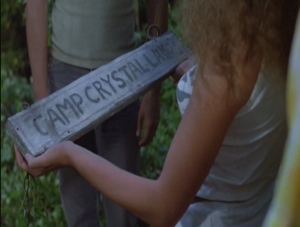
Complaining about formulaic Slasher films is like complaining about historical inaccuracies in Westerns. But since I do that all the time I’m not about to deny myself another intellectual shortcut. I might as well examine the reason why Slashers are so formulaic, and the best way to do that is to examine the film that carved that formula in stone.
Oh, you say, but didn’t Halloween and Friday the 13th Part 1 do that already? Trusting fool. Did you think Hollywood’s run by smart people? It takes more than one or two good films to set a trend…or it used to, back the bad old days of the early 1980s. Sure, Carpenter and Cunningham paved the way for an explosion of half-baked and half-witted imitators and one or two actually-decent serial-killer-centric flicks. But this, a studio-backed sequel which earned back over twenty times its estimated budget, this taught Hollywood (and, by extension, everyone who ever wanted to work there) how to assemble a true-to-life, Grade-F Slasher, altering the face of modern Bad Moviedom in the process by providing a template so soul-crushingly bland it would go on to power the next ten years of increasingly-route, mechanical, and meaningless “horror” movies.
And yes, this is a bad movie by any stretch. So was its prequel, but at least Part 1 had a shred or two of decency. This is just a soulless cash-in – worst than most, better than some – made by money-grubbing hacks who couldn’t even wipe the drool off their chins long enough to hire a decent screenwriter, director, or cast.

In a surprisingly-still-creepy intro, we catch up to Alice (Adrienne King), sole survivor of 1980’s Friday the 13th massacre at Camp Crystal Lake. In one of the longest pre-credit sequences in movie history, we see Alice attempting to put her life back together by ticking off a list of ways to die in a horror film: she showers, sets the kettle on to boil, freaks out at the Spring Loaded Cat and finds Mrs. Voorhees severed head in her fridge. A flannel-clad hand stabs her through the forehead with an icepick and it’s bye, bye, Alice. Nice to spend all that time kinda, sorta getting to know you.
I understand what everyone was going for here. They meant us to sit up and say, “Awww shit, son, they done killed they main character. Nobody’s safe!” Since that’s patently untrue, Alice’s death just seems like a cruel trick the film plays on her and us. So fucking what if you identified with her? the film says. Here, meet the new batch of post-pubescent semi-tards. Identify with them. I dare you.
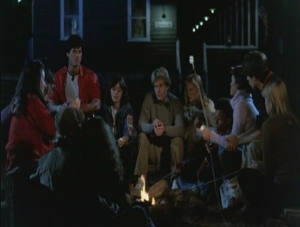 Here Steve Miner and screenwriter Ron Kurz inadvertently shoot any chance of coherent continuity in the face. Jason drowned in 1957, right? His mother killed two councilors the next year and Camp Crystal Lake, understandably, shut down. Steve Cristy reopened it in 1980, drawing Mrs. Voorhees’ ire and stabby-stab-stab. Now Part 2 jumps ahead five years. It’s 1985 and “Camp Blood” is once again condemned, so the film spends most of its time at another “camp councilor training center” just down the lakefront. The important thing is: even the movie’s creators couldn’t come up with another believable reason for this many attractive young people to gather by a lake in the summer.
Here Steve Miner and screenwriter Ron Kurz inadvertently shoot any chance of coherent continuity in the face. Jason drowned in 1957, right? His mother killed two councilors the next year and Camp Crystal Lake, understandably, shut down. Steve Cristy reopened it in 1980, drawing Mrs. Voorhees’ ire and stabby-stab-stab. Now Part 2 jumps ahead five years. It’s 1985 and “Camp Blood” is once again condemned, so the film spends most of its time at another “camp councilor training center” just down the lakefront. The important thing is: even the movie’s creators couldn’t come up with another believable reason for this many attractive young people to gather by a lake in the summer.
Meet them, then…a racially-diverse cross section of canon fodder. Don’t do what I did and worry about keeping everyone straight: we only need to know about the few characters Kurz’s script lowers itself to name.
There’s Sandra (Marta Kober), our Adventurous Spice for the evening, decked out in the shortest pair of shorts this side of a Japanese primary school. There’s the boy hypnotized by her buns, Jeff (Bill Randolph), our Manly Spice/Kevin Bacon analog. There’s Jeff’s friend Ted (Stu Charno), Odious Comic Relief to you. And Terry (Kirsten Baker), A Girl with A Dog named Muffin. Mark (Tom McBride), being wheelchair bound and “in training” for something, fulfills the film’s ADA requirement, while Vicky (Lauren-Marie Taylor) exists for no other reason than to ply Mark with pot and (potential) access to her nether regions.
And that’s it. That’s all we get, because Ginny (Amy Steel), the girl who arrives late in the red Beetle, is an obvious Final Girl from frame one. Who once again seems to have a thing with Paul (John Furey), the Head Councilor (insert cunnilingus joke here). We know Ginny’s our Final Girl because the script lavishes her with the lion’s share of early character development…by which I mean we learn she’s studying “child psychology”…and nothing else. Christ, at least Alice got to hint at having a life outside these damn, death-cursed woods. Still, this bit of background’s enough to cull Ginny from the New Meat herd as effectively as her long dress and non-form-fitting top.
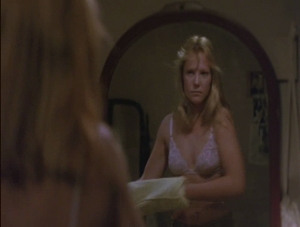
Here we see a series that had already jumped its shark. About fifty minutes in, Ginny delivers a monologue that no doubt sprung full-grown, like Athena, from Ron Kurz’s head. Her speech paints a picture of Jason Voorhees (the killer who’s been stalking everyone this whole time) as an isolated, friendless, “child trapped in a man’s body,” a negative-Batman, become vengeance because he misses his mommy sooo badly. Fans of the series love to use this bit of drunken rambling to justify their own sympathies for Jason Voorhees…rather than own up to their misanthropy and start alienating friends and loved ones like all the rest of us who have balls.
Not that I begrudge them their delusion…it’s just that Part 1‘s pointless, literally-tacked-on cliffhanger ending suggested Jason was a waterlogged zombie at best, raised from the lake by his mother’s demise at the hands of Alice Highwaist. Yet here he is! Ecce homo, fully grown and exacting bloody revenge on similarly-sized adults. If he didn’t drown back in 57, what drove Momma Voorhees over the edge? If he did, who’s this thirty-something huffing it around the woods, taking down lawmen with claw hammers and ripping up cute widdle dogs?
Plenty of time to wonder about all this. Collectively, Crystal Lake’s latest harvest has all the screen chemistry of a high school Christmas recital performed by heroin addicts just coming down, so there’s no reason to listen to their nonsense. Thanks to them, the film drags like a bastard. Fifty minutes into Part 1 all but three of the main cast were dead and our Final Girl dance was about to begin. At least Mrs. Voorhees had a sense of pacing to her murders. Sonny Boy just stalks around the woods before he gets his real killing done, providing those of us who’ve given up caring with only four dead humans and one dog to sate our bloodlust through this slow time. Then we still have an hour of one-note characters bleating at each other to get through before the real movie can begin.
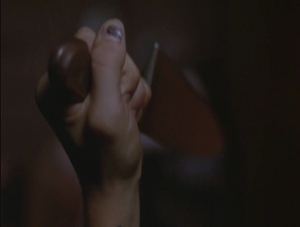
Memo to Ron Kurz: sexual innuendo and skinny-dipping do not substitute for character development. Nor do scatological jokes, no matter how clever you think they are. If I lean on a piano key over and over for an hour my audience will grow bored. Everything here feels assembled from the cheapest off-the-shelf parts you could find. I know you were in a hurry, but did you and Steve Miner have to rip-off The Town that Dreaded Sundown and Twitch of the Death Nerve? Again? Twice in two movies ain’t just coincidence: that’s Group Think, Destroyer of Worlds and good ideas.
This is as good a place as any to mention something I’ve been wanting to bring up for awhile: movie studios do not care about movies. Individuals within those studios might say they do, but as organizations the studio can no more care for the quality of a film than a Terminator could care about why human’s cry. To them, we’re just hands clutching money, flying at them like out-of-control freight trains driven by drunks. They’re nothing but cowards who jump on the first bandwagon they see, and ride it right off the rails every damn time. You think people want to watch stale, whitebread characters die horribly? You think this is horror? No, my friend. Paramount thinks we think this is horror. They thought kids like me would mistake it for horror back in 1981, and you know what? They were right. So they did what all capitalists do and continued to supply a demand they themselves manufactured.
That’s the beauty of what Theodore Adorno called “the culture industry”: grade school economic notions reverse themselves faster than a Federation starship’s deflector shields. Think about it. You grow up watching William Castle flicks, Universal and AIP horror movies, or Roger Corman’s Golden Age. Suddenly you wake up in the 70s. Here’s Night of the Living Dead, The Texas Chainsaw Massacre, Last House on the Left, The Hills Have Eyes, The Exorcist, Rosemary’s Baby, the Hammer Horror pictures (if you were lucky) and by the 1978 you helped make Halloween the legend it is today.
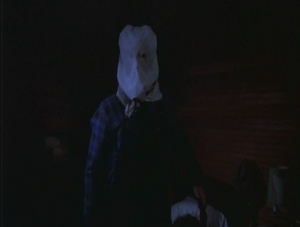
Suddenly serial killers are everywhere. Horror films unrelated to mass murder become few and far between. No more Amityville Horrors (that were any good). No more cannibal families, except Leatherface’s…and even they traded anything that might actually be scary for a whole lot of fake blood. Rather like this sub-genre as a whole.
It ran away from them is what it did: Sean Cunningham bottled lightning, Paramount bought it up, and this is them selling it back to us. Same Coke, new label. Same shit, different day. Cosmetic differences don’t amount to a hill of beans in this crazy world, Elsa. There’s no bullshit mystery surrounding the killer’s identity here, and Steve Miner does not play any real tricks on the audience…unless you count the film itself as one sick April Fool’s joke.
Thanks to this film, and his next one, Miner won a hot-shot director’s reputation for knowing how to bring the Scary. Except he doesn’t. You don’t need flair when you’re directing your entire picture in the “follow victim around room until their death” style. There are, maybe, two shots in the film that actually work on the nerves…and conveniently enough they both come near the end.
For this Friday ends with one of the most memorable Final Girl sequences in history, the only reason I bore fond memories of it, and the only real reason to ever see this flick. We learn more about Ginny in this fifteen minutes of fight-n’-chase than a fist full of expository monologues could’ve possibly taught us.

Here she proves empathetic, resourceful, and unafraid to knee her opponent in the groin. Steel also endears herself further by playing scared without the all the damned whimpering Adrienne King and Jamie Lee Curtis made so famous. My unground teeth would like to declare Ginny my official Favorite Final Girl, but that would be blasphemy. After all, Heather Langenkamp still exists, and I dare not offend the Goddess.
Ah…but the film can’t let me escape without crushing one last hope. Up until this point, Jason’s killed everyone he’s come into contact with, including Muffin the dog. (And I say unto this film, “Good.”) At the start of Ginny’s run through the Final Girl Olympics, Jason confronts Paul and subdues him off screen. Then, near the end, when it looks like all hope is lost…the film jumps the shark again by having Paul return from the dead, distracting Jason just long enough for…well, if you don’t know, I imagine you can guess. Then they bring the dog back to life…right before the tacked-on and pointless “chair-jumper” ending. Because let’s face it, baby: by 1981, you just had to have a sequel.
If it’s anything, Part 2 is a necessary evil on your way to Part 3 and the much better Friday‘s beyond. It could serve as the litmus test for potential converts. If you like this, expect much, much, much more of the same, some of it better. Most of it much, much worse.
![]()
![]()
